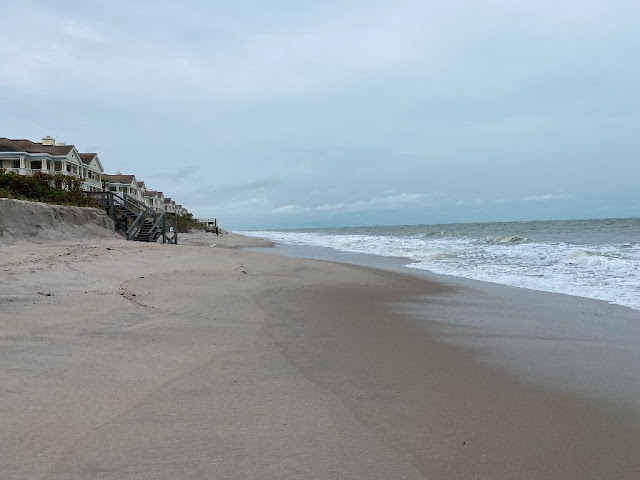Written by the TreasureGuide for the exclusive us of the Treasure Beaches Report.
 |
| Beachcomber Lane Around 11:30 AM Wednesday, |
As you probably know, Tuesday night and Wednesday morning we had a peak surf that was supposed to be around ten feet or so. I was not able to get out to the beach Wednesday, but in case you were wondering how things developed, DJ went out and sent some beach photos.
The above photo was taken around Beachcomber Lane late morning on Wednesday. DJ said the sand had accumulated about four feet since his last photo from there and it was mushy.
Moving on to more familiar territory, he also visited Turtle Trail, Seagrape Trail and Ambersands.
 |
| Turtle Trail Around Mid-day Wednesday. |
 |
| Turtle Trail Around Mid-day Wednesday. |
The following photos were taken down by the second flagpole.
 |
| Turtle Trail By The Second Flagpole Wednesday. |
He mentioned that very little of the blue bag cloth was showing.
 |
| Turtle Trail Second Flagpole Areas Wednesday. |
Next to Seagrape Trail.
 |
| Seagrape Trail Early Afternoon Wednesday. |
 |
| Seagrape Trail Early Afternoon Wednesday. |
Next is Ambersands.
 |
| Ambersands Early Morning Wednesday. |
Thanks to DJ for all of those photos.
How do you learn to predict? The answer is from what has happened in the past. What things lead to what things? In the case of beach erosion and productivity, what events lead to erosion and productive beaches? Those things are not exactly the same. Erosion can be productive but is not always. You can have erosion without the beaches becoming productive.
Some people take the beach photos wrong. They provide data. The photos tell you what happened in the past, which is the beginning to predicting what will happen in the future. Put together the wind, surf, tides, prior beach conditions etc. and you will start to understand how it works and what leads to what. Predictions are seldom perfect though, so it is always better to be there, but you can't be everywhere. Therefore, by learning to predict some of these things, you will have better chance to be at the right place at the right time.
There have been a lot of good hints in some of my recent posts if you paid attention to the right things. You might say, "It is better to teach a man to fish, than give him a fish."
You can tell someone when a beach is producing, but by the time you do that and he gets there, some of it is over, and secondly, there will be other places that are producing, and wouldn't you rather discover those spots for yourself.
I know some people say the photos of yesterday are too late. But tomorrow's beaches develop from today's beaches. What is the starting place, and what are the forces acting on the beaches? Those are two things you need to know. You can get a head start when you put that all together.
And were your previous estimates accurate? Did you correctly guess what the beaches were going to do? You need that feedback. If you guessed the Wednesday beaches would develop differently than they did, why? What did you miss? What did you not take into account or what did you figure incorrectly? Learning requires a feedback loop. Were you correct or incorrect in the past? Why? How can you improve your understanding? You can learn a lot by figuring out why you were wrong. That is how you correct your performance.
It is important to know what happened. Some people just want you to mark the spot. They just want the fish, when they would be better off learning how to fish.
The photos shown above show Wednesday's beaches. So given that starting point and considering the forces that will come to bear including surf, winds, tides, etc. what will they look like tomorrow.
Again, you won't be able to predict perfectly, but you will be able to improve your chances. One of the reasons you won't be able to predict perfectly is the data you use will not be perfect. I've pointed out many times that the MagicSeaWeed predictions are not always perfectly correct. Therefore there is some error variance introduced by those predictions when you use those predictions for your predictions.
I hope you now better understand how to use the beach photos. In the photos you saw, there was no major erosion even though we had some pretty rough surf. So the most general thing you might conclude is that it takes more than a rough surf to produce erosion - especially the kind of erosion that makes beaches productive. That is nothing new or surprising. I've been saying that for years, but I've also been pointing out some of the other important variables.
Another thing you have to consider is those special situations, such as beaches that have some special feature, ie. rocks, seawalls, etc.
But that is all I have time to post now.
Good hunting,
TreasureGuide@comcast.net.